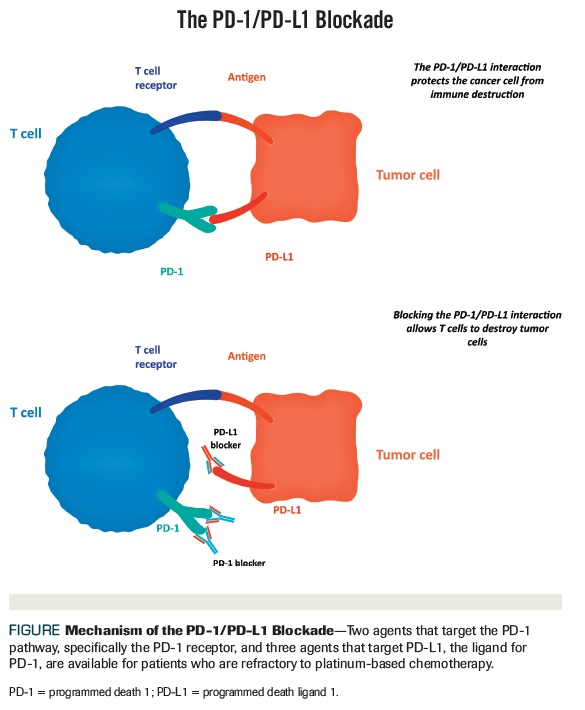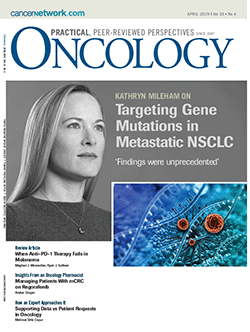Recent Clinical Trials Explore Immunotherapies for Urothelial Carcinoma
Dr. Balar highlights promising evidence on the potential benefits of the use of immunotherapy in the advanced bladder cancer setting.
Oncology (Williston Park). 33(4):132-6.

Arjun V. Balar, MD

Figure. Mechanism of the PD-1/PD-L1 Blockade

Urothelial carcinoma is the most common type of bladder cancer. Recently, two clinical trials explored the use of immunotherapy to treat patients with urothelial carcinoma. Additional research is also underway. In this interview, ONCOLOGY spoke with Arjun V. Balar, MD, the director of the Genitourinary Medical Oncology Program at New York University Langone’s Perlmutter Cancer Center. Dr. Balar, who specializes in the treatment of patients with bladder, prostate, kidney, and testicular cancers, discussed the treatment landscape for urothelial carcinoma, as well as promising advances that have the potential to change practice.
Q: Several immunotherapies have now been approved by the US Food and Drug Administration (FDA) for the treatment of urothelial carcinoma, both for treatment-naive patients and those with relapsed/refractory disease. Can you provide a brief overview of these therapies?
DR. BALAR: The current landscape of available immunotherapies for advanced bladder cancer can be broken down into two disease states. The first group, the disease state that was tested during initial development, includes patients who are refractory to platinum-based chemotherapy-including cisplatin- or carboplatin-based treatments. In this setting, five different FDA-approved agents are available: two agents that target the programmed death 1 (PD-1) pathway, specifically the PD-1 receptor, and three agents that target programmed death ligand 1 (PD-L1), which is the ligand for PD-1 (Figure). Essentially, these drugs lead to a range of responses from 15% to 21%.
There are two trials involving two agents that have shown a benefit vs chemotherapy, which was the standard of care before immunotherapies were available: a study of pembrolizumab[1] and an intent-to-treat analysis from an atezolizumab study.[2] In the first-line setting, these two FDA-approved agents are available for patients who are cisplatin-ineligible. Both agents were tested in single-arm clinical trials focused on patients with advanced bladder cancer who were ineligible for cisplatin-containing chemotherapy. The data from these studies demonstrated a response rate in the range of 23% to 29% and a median survival as high as 15.9 months, which was observed with atezolizumab.[2]
More recently, we found more evidence from two separate randomized trials informing us how best to use these agents in the cisplatin-ineligible patient population. Specifically, safety alerts from two randomized phase III trials, KEYNOTE-361[3] and IMvigor130,[4] showed that patients with low levels of PD-L1 expression did better if they received platinum-based therapy rather than immunotherapy. As a result, in August 2018, the FDA amended the prescribing labels for both atezolizumab and pembrolizumab to limit their use to cisplatin-ineligible patients with advanced bladder cancer who have low PD-L1 expression or are ineligible for any platinum-containing chemotherapy. In addition, the prescribing information was updated to require the use of an FDA-approved test specific for each individual agent to better guide patient selection.[5]
Q:Ongoing trials are now combining immunotherapy with either another immunotherapy agent or with another modality, such as a targeted agent or chemotherapy. In February of this year, the results of the PIVOT-02 trial were released.[6] This trial focused on front-line treatment of advanced or metastatic urothelial carcinoma with a combination of NKTR-214 and nivolumab, which is approved on its own to treat bladder cancer. Can you tell us more about the design and results of PIVOT-02?
DR. BALAR: PIVOT-02 is a fairly large phase I study that served as the initial development platform for the agent NKTR-214. Specifically, this agent is essentially a reformulation of one of the oldest immunotherapy compounds to be tested in cancer, interleukin-2. Going back to the 1990s, interleukin-2 was administered as a high-dose intravenous bolus treatment for 5 consecutive days in a monitored intensive care treatment setting within the hospital because it causes an intense systemic immune response that causes patients to become quite sick; however, at the end of therapy, up to 10% of patients with advanced kidney cancer were essentially cured of their stage IV disease.
Now, fast forward to the 2010s, and this agent was reformulated by adding 6 polyethylene glycol (PEG) molecules to create a slow-release formulation. As the PEG molecules decrease from 6 PEGs down to 2, the active form of the cytokine is then present in the body, allowing immune stimulation, as well as preferential immune stimulation toward immune effector T cells, while minimizing stimulation of the suppressive T cells (regulatory T cells).
The PIVOT-02 study tested nivolumab in combination with NKTR-214, which was administered once every 3 weeks in the outpatient setting, so that the toxicities were much milder compared with patients receiving high-dose interleukin-2. In this particular study update, a cohort of 41 patients with advanced bladder cancer who were treatment-naive received first-line nivolumab and NKTR-214. The data were presented at the 2019 American Society of Clinical Oncology Genitourinary Cancers Symposium and included the 27 efficacy-evaluable patients, defined as those who had at least one response-evaluable imaging after starting protocol therapy. Essentially, the researchers found that up to 48% of patients achieved an objective response according to Response Evaluation Criteria in Solid Tumors (RECIST) criteria, and 52% of patients had an immune-related RECIST response. Additionally, of the 15 patients with visceral metastases, 8 had responses to therapy. So, this agent seems to be quite active, even in patients with visceral metastases.[6]
Interestingly, 6 patients achieved a complete response, suggesting that NKTR-214 is quite active and may actually deepen responses in combination with nivolumab. A subgroup correlative analysis of this study found that, among patients who underwent an on-treatment biopsy vs a baseline biopsy, an influx of CD8+ T cells were present within tumors; in addition, the level of PD-L1 expression increased among patients who received combination therapy, suggesting that NKTR-214 can actually induce a more vigorous local immune response.[6] While these data are promising, they involve only the 27 efficacy-evaluable patients; the study is ongoing and will enroll more patients. Ultimately, randomized trials will be necessary to really understand what NKTR-214 truly adds to nivolumab monotherapy for patients with advanced bladder cancer.
Q:Pembrolizumab is now being tested in earlier stages of disease. The results of the phase II PURE-01 clinical trial of pembrolizumab as a neoadjuvant therapy before cystectomy in patients with muscle-invasive bladder cancer were reported last year.[7] Can you tell us about the results of this trial and their potential significance for early-stage disease?
DR. BALAR: PURE-01 was a very interesting study in that it tested neoadjuvant immunotherapy in patients with muscle-invasive bladder cancer who then underwent radical cystectomy. The historical standard of care for muscle-invasive bladder cancer is cisplatin-based chemotherapy for up to 4 cycles followed by a radical cystectomy. We use neoadjuvant therapy followed by cystectomy because we have level I evidence that the addition of chemotherapy in this setting improves survival and the rate of cure.
In the PURE-01 study, all patients were eligible for cisplatin-based chemotherapy but opted to participate in this trial; therefore, they received 3 doses of pembrolizumab immunotherapy administered every 3 weeks (6 to 9 weeks of treatment total) followed by a radical cystectomy, the standard-of-care surgical procedure with a curative intent. Essentially, the data showed that approximately 40% of patients achieved a complete pathologic response, suggesting that the addition of pembrolizumab elicited a significant local tumor immune response such that in 40% of patients, all cancer present in the bladder at the time of surgery was eradicated.[7]
These data are provocative because we have historically used the response rate to cisplatin chemotherapy as a surrogate for long-term survival. That is because data from the Southwest Oncology Group (SWOG) 8710 trial,[8] one of the pivotal studies that established cisplatin-based therapy as the neoadjuvant standard of care, showed that patients who achieved pT0 had a long-term cure rate of roughly 85% to 90%. The rate with which we see pT0 with cisplatin is estimated to be between 30% and 40%. So, to see a similar rate of pathologic complete response with neoadjuvant immunotherapy suggests that we may be able to see similar efficacy in the bladder.
These are promising data because more patients can tolerate pembrolizumab or immunotherapy in general compared with cisplatin. The challenge with this particular study is that it is a single-arm trial, so we don’t have any comparisons to other active treatments; furthermore, we don’t know whether the complete response in the bladder to pembrolizumab means the same thing as a complete response to cisplatin therapy. This is where long-term follow-up via randomized trials is absolutely necessary.
All of that being said, these data are very important and certainly lend a lot of background and evidence to support conducting larger randomized trials in which patients receive neoadjuvant immunotherapy followed by cystectomy and then are followed to see whether the rates of cure are improved compared with radical cystectomy alone. Not surprisingly, a subgroup analysis of the PURE-01 study showed that patients with high levels of PD-L1 expression in their baseline tumor sample were far more likely to achieve a pathologic complete response to immunotherapy,[7] which is in line with what we typically see in the metastatic setting. Additional data and analyses will be necessary to test if other biomarkers, such as tumor mutational burden or specific genetic mutations, might predict which patients will do best with neoadjuvant immunotherapy.
Q: Are there additional neoadjuvant studies utilizing immunotherapies in bladder cancer that are either ongoing or planned in order to better understand how these therapies fit into treatment?
DR. BALAR: Several randomized phase III trials testing immunotherapy in the neoadjuvant setting are either currently open or soon-to-be open. These include two studies focusing on pembrolizumab. The first is a randomized phase III trial evaluating cisplatin-based chemotherapy alone vs cisplatin-based chemotherapy plus pembrolizumab followed by radical cystectomy.[3] The second study is looking at neoadjuvant pembrolizumab alone followed by radical cystectomy vs radical cystectomy alone in patients who have muscle-invasive bladder cancer but are not candidates for cisplatin-based chemotherapy (KEYNOTE-905; not yet listed on ClinicalTrials.gov). Lastly, a randomized phase III trial testing the PD-L1 antibody durvalumab in combination with cisplatin-based chemotherapy followed by radical cystectomy vs cisplatin-based chemotherapy alone followed by radical cystectomy is underway (ClinicalTrials.gov identifier: NCT03732677). These three studies are just a sampling of the current trials that are better designed to ultimately answer the question, “How much does immunotherapy add to the neoadjuvant setting?”
Q: Besides the trials we already discussed, are there any additional ongoing trials focusing on immunotherapy for bladder cancer that you and your colleagues are excited about or that have the potential to be practice-changing?
DR. BALAR: An additional area that I am particularly excited about is bladder preservation. The idea is definitive local treatment for muscle-invasive bladder cancer with a curative intent that does not require a radical cystectomy, which has a very high morbidity; up to two-thirds of patients who undergo radical cystectomy experience perioperative complications, and up to 1% to 2% of patients die from surgery-related complications. Trimodality bladder preservation is a well-established approach that first includes a maximal resection of the bladder, where the bulk of the tumor is removed. Patients are subsequently treated with a 4- to 6-week course of radiation; radiosensitizing chemotherapy is given concurrently to augment the effect of radiation, with the ultimate goal of curing the disease without having to surgically remove the bladder.
I am particularly interested in the addition of immunotherapy to trimodality bladder preservation. I am leading a phase II trial in which we are adding pembrolizumab in combination with trimodality bladder preservation (ClinicalTrials.gov identifier: NCT02621151). We have enrolled just over 30 patients in the last 2 years, and our goal is to enroll 54 patients total. So far, we are seeing encouraging outcomes and excellent safety results. The study is designed for patients who wish to preserve their bladder, as well as for older patients, who are commonly affected by this disease but are not surgical candidates.
A SWOG trial (ClinicalTrials.gov identifier: NCT03775265) is testing definitive chemoradiation and bladder preservation for muscle-invasive bladder cancer with and without atezolizumab as part of a randomized phase III trial that will enroll close to 500 patients. This study will activate in the coming months, and will more definitively test whether adding immunotherapy to chemoradiation will improve our ability to cure patients with muscle-invasive bladder cancer and, most importantly, help them to keep their bladders.
A great deal of evidence exists to support this strategy. Most recently, the PACIFIC trial evaluated patients with stage III non–small-cell lung cancer treated with definitive chemoradiation and then randomized to receive adjuvant durvalumab or adjuvant placebo. The updated data from that trial, published in the New England Journal of Medicine in fall 2018, showed significantly improved disease-free survival, with a hazard ratio close to 0.5, as well as significantly improved survival with the addition of durvalumab to chemoradiation.[9] These data suggest that immunotherapy truly does synergize with chemoradiation and hopefully induces a more potent and systemic immune response. This would allow us to eradicate not only the disease that is irradiated, but also systemic micrometastases, by initiating a more effective immune response.
Financial Disclosure:Dr. Balar has a speaking agreement with and serves on advisory boards and as a consultant for AstraZeneca, Genentech, Incyte, Merck, and Pfizer/EMD Serono.
PERSPECTIVE

Present and Future Outlook for Immunotherapy in Urothelial Cancers
Pedro Barata, MD, MSc
Immune checkpoint inhibitors have transformed the treatment landscape for urothelial cancers, with the approval of 5 different agents for patients with metastatic disease in less than 3 years. The enthusiasm for these therapies has been sustained by the potential durable response rates and tumor control combined with their safe and favorable adverse event profile.
However, a wave of disappointment surged when one of the confirmatory phase III trials with atezolizumab (IMvigor211) failed to demonstrate a survival advantage vs chemotherapy for the second-line treatment of metastatic urothelial carcinoma.[1] And it persisted when the US Food and Drug Administration restricted the front-line use of pembrolizumab and atezolizumab to those with elevated programmed death ligand 1 (PD-L1) expression[2] following the decrease in survival observed in patients with low PD-L1 status in the single-arm immune checkpoint inhibitor–treated cohorts of the IMvigor130[3] and KEYNOTE-361[4] studies.
As it stands today, overall response rates are still relatively low for unselected patients. For those fortunate patients who respond, however, the durability of the responses is typically high. Additionally, our ability to predict responders is limited, and more research on predictive biomarkers is needed.
Driven by our improved understanding of cancer immunology and the successful results seen in other diseases such as lung and kidney cancer, a wealth of very interesting clinical trials are currently testing immune checkpoint inhibitors in different clinical settings. This research is nicely summarized by Dr. Balar in this interview. Several studies are testing the combination of immunotherapy with chemotherapy, or with different immunotherapies, in the advanced-stage setting. Others are testing immune checkpoint inhibitors in curative stages, either as monotherapy or combined with other treatment modalities such as radiation therapy.
Preliminary efficacy data from these studies are very promising and open the door to significant changes in the management of this disease. Will immune checkpoint inhibitors replace chemotherapy as neoadjuvant therapy? Can we skip radical cystectomy in patients who achieve a complete response? Should we think about bladder preservation as a true alternative? Is a combination chemotherapy/immune checkpoint inhibitor regimen the next standard of care for metastatic cancer patients?
We don’t know…yet.
Financial Disclosure:Dr. Barata has no significant financial interest or relationship with the manufacturer of any product or provider of any service mentioned in this article.
Dr. Barata is an Assistant Professor in the Department of Internal Medicine, Section of Hematology and Medical Oncology, at Tulane Medical School, New Orleans, Louisiana, with a focus on genitourinary cancers and clinical trials.
References:
1. Bellmunt J, de Wit R, Vaughn DJ, et al. Pembrolizumab as second-line therapy for advanced urothelial carcinoma. N Engl J Med. 2017;376:1015-26.
2. Powles T, Durán I, van der Heijden MS, et al. Atezolizumab versus chemotherapy in patients with platinum-treated locally advanced or metastatic urothelial carcinoma (IMvigor211): a multicenter, open-label, phase 3 randomised controlled trial. Lancet. 2018;391:748-57.
3. Powles T, Gschwend JE, Loriot Y, et al. Phase 3 KEYNOTE-361 trial: pembrolizumab (pembro) with or without chemotherapy versus chemotherapy alone in advanced urothelial cancer. J Clin Oncol. 2017;35(suppl):abstr TPS4590.
4. Galsky MD, Grande E, Davis ID, et al. IMvigor130: a randomized, phase III study evaluating first-line (1L) atezolizumab (atezo) as monotherapy and in combination with platinum-based chemotherapy (chemo) in patients (pts) with locally advanced or metastatic urothelial carcinoma (mUC). J Clin Oncol. 2018;36(suppl):abstr TPS4589.
5. US Food & Drug Administration. FDA limits the use of Tecentriq and Keytruda for some urothelial cancer patients. https://www.fda.gov/drugs/informationondrugs/approveddrugs/ucm612484.htm. Updated July 5, 2018. Accessed March 15, 2019.
6. Siefker-Radtke AO, Fishman MN, Balar AV, et al. NKTR-214 + nivolumab in first-line advanced/metastatic urothelial carcinoma (mUC): updated results from PIVOT-02. J Clin Oncol. 2019;37(suppl):abstr 388.
7. Necchi A, Anichini A, Raggi D, et al. Pembrolizumab as neoadjuvant therapy before radical cystectomy in patients with muscle-invasive urothelial bladder carcinoma (PURE-01): an open-label, single-arm, phase II study. J Clin Oncol. 2018;36:3353-60.
8. Grossman HB, Natale RB, Tangen CM, et al. Neoadjuvant chemotherapy plus cystectomy compared with cystectomy alone for locally advanced bladder cancer. N Engl J Med. 2003;349:859-66.
9. Antonia SJ, Villegas A, Daniel D, et al; PACIFIC Investigators. Overall survival with durvalumab after chemoradiotherapy in stage III NSCLC. N Engl J Med. 2019;379:2342-50.

Newsletter
Stay up to date on recent advances in the multidisciplinary approach to cancer.